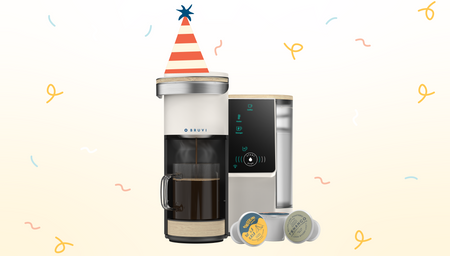How Bruvi® Evaluates Coffee
Here at the Bruvi Lab in Los Angeles, CA we are working around the clock, trying new coffees and roast profiles to determine what will end up in our B-Pods®. The entire process we use to evaluate coffees is quite intricate and involves many stages. At the tail end of this process is arguably the most important step, a complete sensory test, coffee cupping. When you put a bunch of coffee nerds in a room together and force them to smell, taste and evaluate coffee, you can feel the magic in the air. I get giddy just thinking about it, so let’s talk about the best part of our job, testing coffee.
What is Coffee Cupping?
Quite simply, coffee cupping is just a comprehensive evaluation of a coffee’s taste, smell, and overall quality. This can be done by a coffee professional or by any coffee lover interested in comparing coffees. To deliver a specific cupping score that carries merit and directly influences the price of a coffee, the evaluation must come from a certified Q grader. A Q grader has extensive education that gives them the appropriate skillset to deliver an unbiased assessment of coffee.
How to Cup Coffee?
Cupping coffee is a several-step process that may seem daunting at first, but just take it one step at a time and you’ll realize it is quite simple. Follow these ten simple steps to cup coffee like a pro.
Step 1: Weigh 8.25 grams of whole bean coffee.
Step 2: Grind coffee and put it into an appropriate cupping vessel made of tempered glass or ceramic. The cup should hold between 7-9 ounces and have a top diameter of between 3-3.5”.
Step 3: Take notes on the coffee’s dry aroma.
Step 4: Pour 150ml of 200℉ water over the coffee grounds and start the timer.
Step 5: Take notes on the wet coffee’s aroma.
Step 6: After 4 minutes, break the crust by taking your cupping spoon and pushing the coffee grounds to the back of the bowl.
Step 7: Using two spoons, remove all the coffee grounds, foam and oil.
Step 8: After sitting for an additional 4 minutes, begin tasting. Fill your cupping spoon and slurp the coffee so that you can taste the full spectrum of flavors across your tongue. Take notes and don’t be afraid to be a little loud.
Step 9: Taste the coffee two more times, waiting in 4 minute intervals, to capture all your tasting notes as the coffee’s flavors changes with the time and temperature.
Step 10: Deliberate on your coffee notes with friends. Remember that for non-trained professionals, preference is highly subjective and flavor attributes may differ across each palate.

Why is Cupping Coffee So Important to Bruvi?
At Bruvi, we are proud to be a coffee-first company. By putting all coffees through rigorous testing, including cupping, we maintain a level of quality that was previously reserved for only the best specialty coffee roasters in the world. It is through this process that we successfully evaluate countless coffee samples from farmers across the world and pinpoint the ones that will make their way into your cup. Next time you’re drinking a B-Pod, take a moment in honor of all those coffees that were cupped but didn’t make the cut!





